Detouring south into the busiest part of Taichung City’s Qingshui District (清水區) in search of lunch had been a mistake, I realized soon after I’d finished my noodles. When I pointed my bicycle north and began pedaling, I could feel the strength of the winds blasting across the flat landscape. Covering the six or so kilometers to Gaomei Wetlands (高美濕地) took me more than half an hour.
The wetlands, which lie between the mouth of the Dajia River (大甲溪) and the Port of Taichung (台中港), didn’t exist half a century ago. The building of Gaomei Levee in 1976 led to a rapid accumulation of silt and sand. This, coupled with erosion along the southern shore of the Dajia River estuary, resulted in an expanse of tidal mudflats.
In 2004, Taichung County Government — which merged with Taichung City in 2010 — demarcated 701.3 hectares of dry land and seashore as Gaomei Wildlife Sanctuary (高美野生動物保護區). This area includes the most-visited part of the wetlands near the tiny settlement of Yuliao (魚寮).
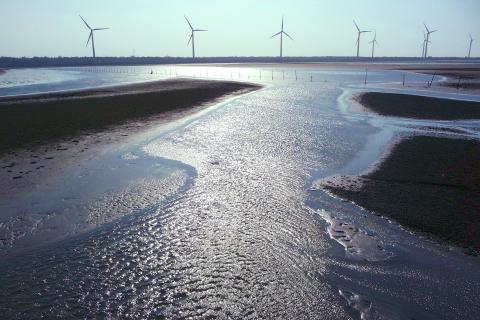
Photo: Steven Crook
Regulations governing the sanctuary prohibit the killing, capturing or harassing of wild birds and animals, and outlaws the destruction of their habitats or of wild plants. Neither animals nor plants can be released or introduced without official permission. Development and construction are prohibited, but if habitats of wild creatures are destroyed, the authorities are empowered to establish “necessary habitat improvement, breeding, conservation, and maintenance and release facilities.”
There’s one important exception to all this, however: local fishermen who are registered in the area are allowed to continue fishing. And that’s to say nothing of the pressure on the local environment caused by tourists, of whom there were scores on the weekday I visited. At peak times, there can be hundreds of people on the 500m-long boardwalk or out on the mudflats.
During the cooler months, some people come here to see waterbirds. BirdLife International’s Web site lists Gaomei as an Important Bird Area for two reasons: At least one globally threatened avian species spends time here, and more than 1 percent of at least one species’ global population gathers here on a regular basis.
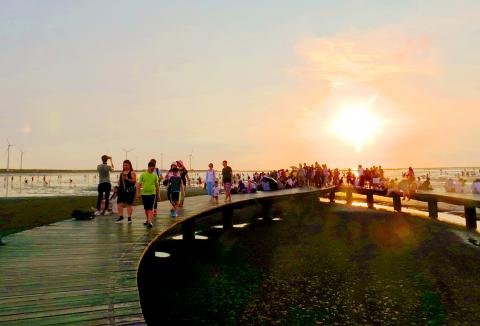
Photo: Chang Ching-ya, Taipei Times
What’s more, Gaomei has Taiwan’s largest colony of Bolboschoenus planiculmis (a type of sedge), and a dense forest of Australian pine trees. The latter were planted as windbreaks, but have become, according to BirdLife International “excellent bird habitat.”
Nevertheless, in a 2012 blog post, a Taiwan-based professional birdwatching guide described the wetlands as “much abused.”
Given the number of humans around, I wasn’t surprised to see just a few birds. It being low tide, however, the crabs were numerous and active. The area is said to have 30 different cancrine species, and I saw fiddler crabs of different colors emerge from their muddy homes right by the boardwalk. I didn’t spot any mudskippers. Perhaps the mudflats are too exposed for their liking.
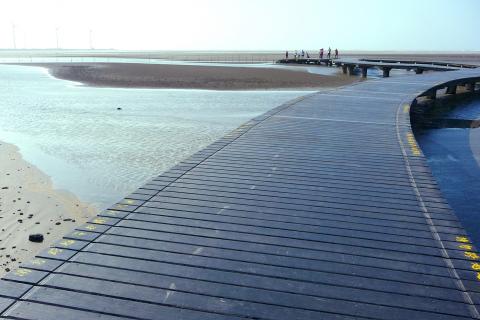
Photo: Steven Crook
While I wouldn’t describe the scenery as beautiful, it did make for a pleasant change from the urban lowlands I’d been biking through. When I got to the end of the walkway, I noticed some tourists had taken off their shoes and set off across the tidal flats. The breakers seemed very far away indeed — but when the tide turns, how fast does the water come in?
Returning to dry land, I took a quick look at Gaomei Lighthouse (高美燈塔), the grounds of which are open to the public from 9am to 5pm through the winter, then until 6pm from April to the end of October. In terms of architecture or setting, it’s far from the most interesting lighthouse in the country, but at least I could get out of the wind for a short time.
The visitors center at the southern end of the levee was a disappointment. Apart from a desultory selection of souvenirs and a few posters, there was nothing inside. Unless you want to use the bathroom or buy a coffee, the only reason to stop here is to enjoy the view from the roof. After gazing out over the wetlands and the nearby wind turbines (it’s well known that birds and turbines don’t get along), I turned to face south.
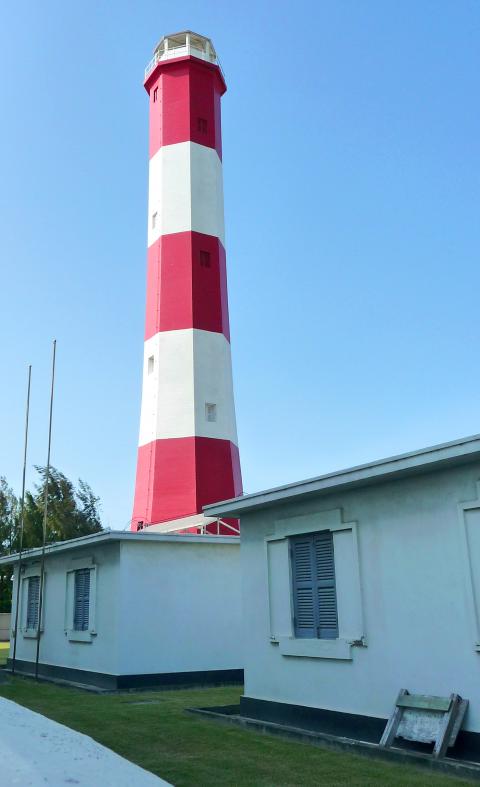
Photo: Steven Crook
A huge and unattractive concrete dome was the most obvious part of the Port of Taichung, less than 3km away. A wonderful thing about Taiwan is that you’re never far from somewhere interesting or even beautiful. The coin has two sides, of course. It’s also hard to escape the industrialization and population density.
The precise opening times of the boardwalk are adjusted according to the tide, but even in winter you can depend on it being open seven days per week, from around 8am until at least 5pm.
If seeing the sunset — which is often stunning — is one of your goals, check the Central Weather Bureau’s (www.cwb.gov.tw) Web site. Look for “Astronomy” on the menu, then choose Taichung in “Central Area” as your location. Between now and the end of this month, the sun will set between 5:11pm and 5:20pm. On the same Web site, if you go to “Fishery” and click on “Tidal Forecast,” you’ll find the high- and low-tide times for Qingshui under “Hsinchu-Lukang Inshore.”
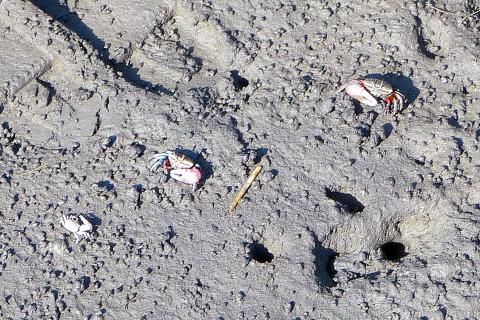
Photo: Steven Crook
Steven Crook has been writing about travel, culture, and business in Taiwan since 1996. He is the co-author of A Culinary History of Taipei: Beyond Pork and Ponlai, and author of Taiwan: The Bradt Travel Guide, the third edition of which has just been published.

Photo: Steven Crook

Aug. 25 to Aug. 31 Although Mr. Lin (林) had been married to his Japanese wife for a decade, their union was never legally recognized — and even their daughter was officially deemed illegitimate. During the first half of Japanese rule in Taiwan, only marriages between Japanese men and Taiwanese women were valid, unless the Taiwanese husband formally joined a Japanese household. In 1920, Lin took his frustrations directly to the Ministry of Home Affairs: “Since Japan took possession of Taiwan, we have obeyed the government’s directives and committed ourselves to breaking old Qing-era customs. Yet ... our marriages remain unrecognized,
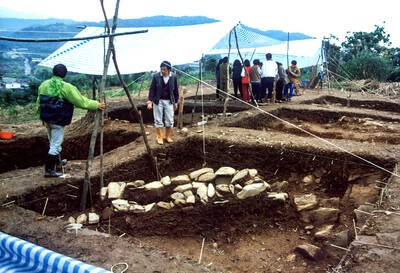
During the Metal Ages, prior to the arrival of the Dutch and Chinese, a great shift took place in indigenous material culture. Glass and agate beads, introduced after 400BC, completely replaced Taiwanese nephrite (jade) as the ornamental materials of choice, anthropologist Liu Jiun-Yu (劉俊昱) of the University of Washington wrote in a 2023 article. He added of the island’s modern indigenous peoples: “They are the descendants of prehistoric Formosans but have no nephrite-using cultures.” Moderns squint at that dynamic era of trade and cultural change through the mutually supporting lenses of later settler-colonialism and imperial power, which treated the indigenous as

An attempt to promote friendship between Japan and countries in Africa has transformed into a xenophobic row about migration after inaccurate media reports suggested the scheme would lead to a “flood of immigrants.” The controversy erupted after the Japan International Cooperation Agency, or JICA, said this month it had designated four Japanese cities as “Africa hometowns” for partner countries in Africa: Mozambique, Nigeria, Ghana and Tanzania. The program, announced at the end of an international conference on African development in Yokohama, will involve personnel exchanges and events to foster closer ties between the four regional Japanese cities — Imabari, Kisarazu, Sanjo and
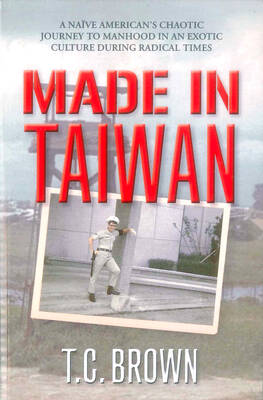
By 1971, heroin and opium use among US troops fighting in Vietnam had reached epidemic proportions, with 42 percent of American servicemen saying they’d tried opioids at least once and around 20 percent claiming some level of addiction, according to the US Department of Defense. Though heroin use by US troops has been little discussed in the context of Taiwan, these and other drugs — produced in part by rogue Chinese Nationalist Party (KMT) armies then in Thailand and Myanmar — also spread to US military bases on the island, where soldiers were often stoned or high. American military policeman